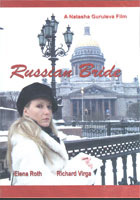
Russian Bride 2005
Distributed by AccentWorks, 3692 Broadway, #53, New York, NY 10031; 212-862-8048
Produced by Natasha Guruleva
Directed by Natasha Guruleva
DVD, color, 60 min.
Jr. High - Adult
Multicultural Studies, European Studies, Gender Studies, Sociology, Women's Studies
Date Entered: 01/14/2008
Reviewed by Kayo Denda, Rutgers UniversityIn this age of globalization, migrants, many of whom are women, leave their home country in search of opportunities abroad. Marriage is an attractive option that provides the security of legal status in countries of destination. The independent feature film Russian Bride is based on a real story and portrays Tanya (Elena Roth), a twenty-one year old from Moscow who comes to New York to marry Blake (Richard Virga), a middle-aged programmer, in the hope for a stable and better life. The film also points to the tragedy of many immigrant women whose lives are shattered by unfulfilled dreams and the harsh reality of isolation, dislocation, and displacement.
Tanya places an ad in the Russian Bride catalog to find an American suitor. Her decision is in part to alleviate her parents’ financial hardship, but it is also based on a naïve and positive stereotype of American men as “honest, passionate, sophisticated, financially secure, sober, and they don’t treat women as poorly as Russian men.” Blake responds to the ad, and followed by a period of courtship via correspondence and despite family concerns, Tanya arrives in New York.
Tanya’s acculturation is similar to countless immigrants who experience difficulty in adjusting to a new life in a new country. As she confines herself to the studio apartment without courage to venture out, the camera focuses on the view outside the window displaying a busy street and, at a distance, the sight of the Empire State Building. Blake and Tanya have very little in common as he is totally immersed in his career and professional connections to which she is totally unfamiliar. Additionally, Blake displays neither understanding of her isolation nor patience for her feelings of displacement. Eventually they break apart, but Tanya decides to stay in New York on her own. The camera follows her struggling with different jobs. Tanya is shown sewing material at a costume studio, cleaning a house, and also performing as a clown, with her face painted, in a park. All these activities reinforce disillusionment and the lack of financial security that emphasizes the notion of powerlessness.
The film presents effective scenes depicting Russian cultural elements and tradition yet is ultimately is undermined by lackluster acting. The folk songs and dances, central to Tanya and her family and in social gatherings in Russia, serve as tools to connect Tanya to the homeland. As she dances to familiar music in Blake’s apartment, she succeeds in traveling back to her lost happiness, thus creating copying mechanisms that enable her to deal with the challenges of everyday life. Despite these qualities, the film is surprisingly flat and presents an unconvincing acting quality. Nonetheless, it brings to the screen another dimension to the narratives of immigration and the limited choices a young woman faces to start an independent life in a foreign country. Recommended for discussions on women’s agency, displacement and subjectivity and globalization.